April 1, 1911 – First Gusher of “Pump Jack Capital of Texas” –
South of the Red River border with Oklahoma, near Electra, Texas, the Clayco Oil & Pipe Line Company’s Clayco No. 1 well launched an oil boom that would last decades. “As news of the gusher spread through town, people thought it was an April Fools joke and didn’t take it seriously until they saw for themselves the plume of black oil spewing high into the sky,” noted a local historian.
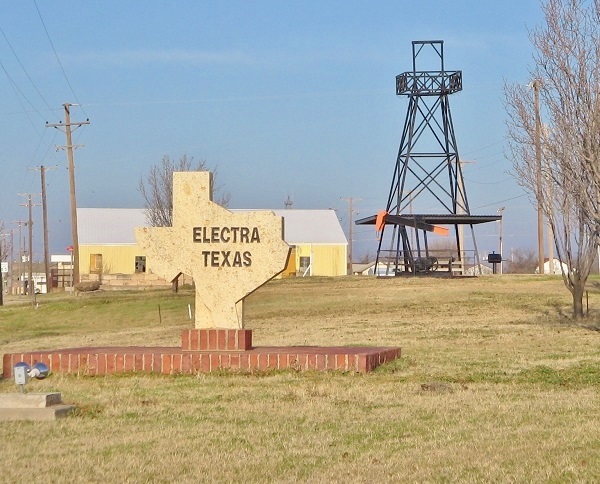
Electra was named after the daughter of rancher W.T. Waggoner, who once complained about finding oil when drilling water wells for his cattle. Photo by Bruce Wells
The well on cattleman William Waggoner’s lease settled into production of 650 barrels per day from about 1,600 feet deep. Hundreds of producing wells followed, leading to the Electra oilfield’s peak production of more than eight million barrels in 1913. Oil fever would return to North Texas in 1917 when “Roaring Ranger” erupted in neighboring Eastland County.
Learn more in Pump Jack Capital of Texas.
April 1, 1986 – Oil Price Collapse
World oil prices briefly fell below $10 a barrel on the New York Mercantile Exchange. Causes included excessive OPEC production, worldwide recession, and a U.S. petroleum industry regulated by production and price controls. Saudi Arabia had slowed its policy of cutting output to support prices.
“The Saudis and other Persian Gulf producers are trying to push oil prices down as part of a long-term strategy to restore their political and economic leverage in the world oil trade,” reported the Washington Post.
April 2, 1980 – President Carter signs Crude Oil Windfall Profit Tax
One year after lifting price controls on oil, President Jimmy Carter signed the Crude Oil Windfall Profit Tax (WPT) into law. It would be repealed eight years later. The controversial WPT levied an excise tax on domestic oil production from 1980 to 1988, according to historian Joseph Thorndike.
The WPT, “imposed an excise levy on domestic oil production, taxing the difference between the market price of oil and a predetermined base price.”
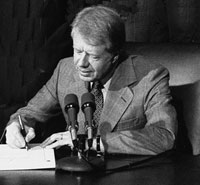
President Jimmy Carter signed the Crude Oil Windfall Profit Tax in 1980. It was repealed in eight years later.
The base price was derived from 1979 oil prices and required annual adjustments for inflation. A remnant of President Richard Nixon’s wage and price controls of 1971 and the OPEC oil embargo, WPT was meant to limit jumps in oil prices. Eight years of the tax resulted in U.S. oil production falling to its lowest point in two decades. The depressed state of the petroleum industry compelled Congress to repeal WPT in 1988.
April 4, 1951 – First North Dakota Oil Well taps Williston Basin
After eight months of drilling in weather that included severe snowstorms, Amerada Petroleum discovered a North Dakota oilfield. The well revealed the Williston Basin two miles beneath Clarence Iverson’s farm near Tioga. Within two months, other exploration companies rushed to the region and leased almost 30 million acres. The petroleum-rich geologic basin proved to extend into Montana, South Dakota, and Canada.
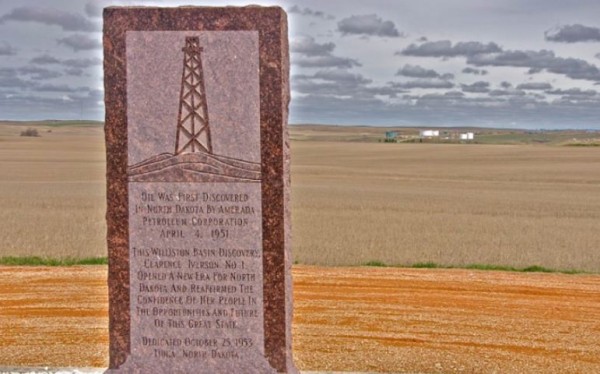
A monument dedicated in 1953 commemorates the Clarence Iverson No. 1 well, which two years earlier discovered the 134,000-square-mile Williston Basin on Iverson’s farm.
The Iverson farm discovery well reached 10,500 feet deep in March 1951 before a blizzard ended operations, according to historian James Key. Drilling resumed until the well was perforated from 11,630 feet to 11,640 feet (using shaped charges at four holes per foot). On the evening of April 4, “a new industry was born in North Dakota,” Key noted. “This was the first major discovery in a new geologic basin since before World War II.”
Learn more in First North Dakota Oil Well.
April 5, 1860 – Oil Industry grows in Pennsylvania
Inspired by Edwin L. Drake’s August 1859 first U.S. oil well at nearby Titusville, Pennsylvania, a newly formed company discovered an oilfield along the Allegheny River at Oil City. With oil fever attracting thousands, five partners organized one of America’s earliest oil ventures, the Phillips, Frew & Company.

Oil discoveries in the Allegheny River Valley established the earliest U.S. petroleum exploration and production companies. Oil City 1896 “Aero View” map by T.M. Fowler courtesy Library of Congress.
After drilling twice as deep as Drake’s well, the company discovered another oil-producing sand formation at a depth of 197 feet. The well produced 42 barrels of oil on its first day, earning the company $882 ($32,977 in 2024 dollars). Within weeks, a shipment of 60 barrels of oil traveled on barges down the Allegheny River to kerosene refineries in Pittsburgh.
April 5, 1976 – Strategic Oil Reserves commercialized
President Gerald Ford signed the Naval Petroleum Reserves Production Act, which for the first time allowed full commercial development of the nation’s three Naval Petroleum Reserves. The legislation resulted from oil shortages created by the 1973-1974 Arab oil embargo.
The act stipulated oil, natural gas, and liquid products produced from the reserves to be sold at market rates by the Department of Energy. According to DOE, California’s Elk Hills field, which produced its one-billionth barrel of oil in 1992, generated more than $17 billion in profits for the U.S. Treasury. The Elk Hills field was privatized in 1998.
April 5, 1979 – Ending Oil Price Controls
A week after a national referendum in Iran overwhelmingly supported becoming the Islamic Republic of Iran, and with U.S. oil prices averaging $15.85 per barrel, President Jimmy Carter initiated phased deregulation of the price controls established by the Nixon Administration in 1971. Deregulating of domestic oil price controls would lead to increased production from Alaska’s Prudhoe Bay oilfields and a sharp decrease in Middle East oil imports (also see Trans-Alaska Pipeline History).
April 7, 1902 – The Texas Company founded during Spindletop Boom
Joseph “Buckskin Joe” Cullinan and Arnold Schlaet established The Texas Company in Beaumont, Texas, to transport and refine oil from the booming oilfield nearby. They would soon construct a kerosene refinery in Port Arthur. Of the hundreds of oil companies founded after a record-setting 1901 gusher at Spindletop, their company would grow into an oil industry giant.
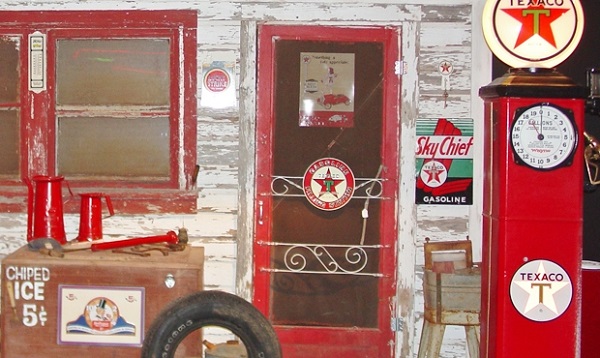
Founded in 1902 as the Texas Company, Texaco would become the first oil company to market in all states. Above, an exhibit at the National Route 66 Museum in Elk City, Oklahoma. Photo by Bruce Wells.
The Texas Company’s Fee No. 3 well at nearby Sour Lake Springs in 1903 launched the company’s success in exploration by producing 5,000 barrels of oil a day. The telegraph address of the company’s New York office was “Texaco” — a name that would later be used for its products.
The Texas Company in 1909 registered its trademark of a red star with a green capital letter T. By 1928, the company and its Texaco nickname operated more than 4,000 gasoline stations nationwide. The company officially renamed itself Texaco in 1959.
Learn more in Sour Lake produces Texaco.
April 7, 1966 – Cold War Accident boosts Offshore Technology
A robotic technology soon adopted by the offshore petroleum industry was first used to retrieve an atomic bomb. America’s first cable-controlled underwater research vehicle (CURV) attached cables to recover the weapon lost in the Mediterranean Sea.
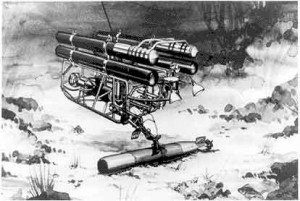
The offshore petroleum industry would becoming a leading user of remotely operated vehicles.
The 70-kiloton hydrogen bomb, which had been lost when a B-52 crashed off the coast of Spain in January, was safely hoisted from a depth of 2,850 feet.
“It was located and fished up by the most fabulous array of underwater machines ever assembled,” proclaimed Popular Science magazine. During the Cold War, the Navy developed deep-sea technologies that the offshore petroleum industry would adopt and continue to advance.
Learn more in ROV – Swimming Socket Wrench.
_______________________
Recommended Reading: Texas Oil and Gas, Postcard History (2013); The Prize: The Epic Quest for Oil, Money & Power (1991); The Bakken Goes Boom: Oil and the Changing Geographies of Western North Dakota
(2016); The Texaco Story: The First Fifty Years, 1902-1952
(2012); Mapping the Deep: The Extraordinary Story of Ocean Science
(2002). Your Amazon purchase benefits the American Oil & Gas Historical Society. As an Amazon Associate, AOGHS earns a commission from qualifying purchases.
_______________________
The American Oil & Gas Historical Society (AOGHS) preserves U.S. petroleum history. Please become an AOGHS annual supporter and help maintain this energy education website and expand historical research. Contact bawells@aoghs.org. © 2024 Bruce A. Wells. All rights reserved.


